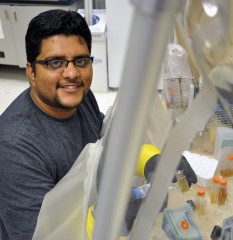Feb
3
Make Biodiesel Production Waste Into Fuel
February 3, 2011 | 1 Comment
Keerthi Venkataramanan, a student in University of Alabama Huntsville’s biotechnology PhD program has found a strain of bacteria deep in the soil and is studying its ability to convert waste from biodiesel fuel into several useful materials, including another alternative fuel.
Venkataramanan is developing biological tools to make products from crude glycerol – the main waste material from the production of biodiesel. The National Science Foundation is funding his research. He is working with the Clostidium pasteurianum bacteria, which “eats” glycerol and produces several potentially useful byproducts.
Venkataramanan explains, “This strain is found deep in the soil. It was originally studied for its ability to ‘fix’ nitrogen from the air.” The bacteria use glycerol as a carbohydrate source. From that they produce three alcohol byproducts — butanol, propanediol and ethanol — plus acetic acid and butyric acid. Butanol is a particularly interesting byproduct.
“Butanol is a big alcohol molecule, twice as big as ethanol,” Venkataramanan said. “You can use it as an industrial solvent and it can be used in cars, replacing gasoline with no modifications. It doesn’t have some of the problems you have with ethanol, such as rapid evaporation. And ethanol is a two-carbon molecule, but butanol is a four-carbon molecule so its energy value is much higher. In fact, there are plans to use it for jet fuel.
“You can also get butanol from crude oil, but this biological process is less polluting.” an encouragment from Venkataramanan.
At the current state of the research the bacteria convert about 30 to 35 percent of the glycerol feed into butanol and another 25 to 30 percent into a chemical used to make plastics. Venkataramanan is looking at different strategies to improve that yield. He is also studying the bacteria’s genes to see if a more productive strain can be bioengineered.
Disposing of glycerol is a major problem for the biodiesel industry. The volume of glycerol produced is daunting, at about 100,000 gallons of glycerol produced with every million gallons of biodiesel manufactured from animal fats or vegetable oils. There’s an ocean of vegetable oil out there that can be used for fuel – getting some value out of the glycerol is a key matter for controlling costs.
In 2009, a not very good year in the U.S., more than 500 million gallons of biodiesel were produced in the U.S. while more than 2.75 billion gallons was produced in Europe. That yields 325 million gallons of glycerol. Getting rid of it is a problem, Venkataramanan notes that two American companies operating in the EU were made to close biodiesel plants because they couldn’t dispose of their crude glycerol.
Other scientists groups in the U.S. and internationally both academically and industrially are studying a variety of fungi, bacteria and algae for glycerol conversion, but Venkataramanan says his strain has several advantages. Some of the other bacteria being studied are dangerous pathogens, while Clostidium pasteurianum “is a completely non-pathogenic strain,” he said. “An accidental release is not a big deal. You get it from the soil, so if you spill any you’re putting it back in the soil.”
It looks good. Coming up with products with value rather than an expensive waste problem bodes well for adding animal fat and vegetable oil products into the fuel stream. Worldwide the glycerol matter must be huge, but good data is only available in the U.S. and EU. Where all that glycerol is winding up is a significant question. Dumping it isn’t a really good idea, even though it’s biodegradable, glycerol would suffocate whatever it coats.
The encouraging point is even at this first stage where about 10% of the bio oil isn’t getting to a product; this young man has closed up the gap by at least 55% perhaps 65%. That leaves only 4% or so left to work out.
Meanwhile, when the research is shown to be scaleable the capital will flow. The standing waste storage will allow more than twice the amount of bio oil to be processed before the ‘disposal wall’ is ran into.
One only wonders what the waste remnant is when Venkataramanan’s bug gets done and what it might be worth.
Comments
1 Comment so far



Very cool!